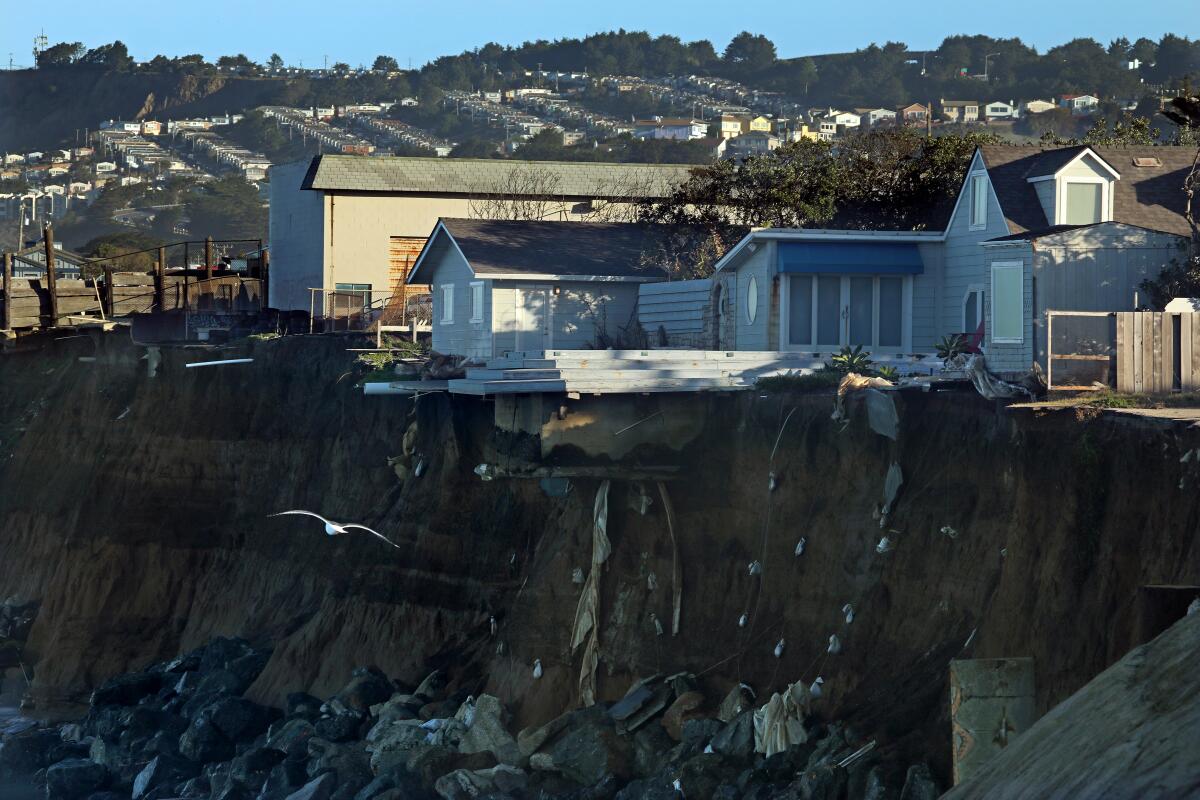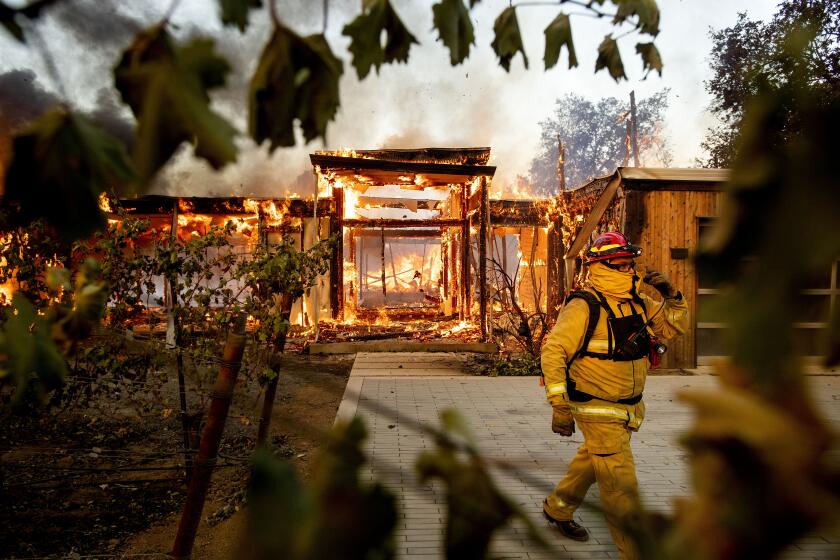California has to rethink building homes in climate-threatened areas

- Share via
California has two competing crises. The state’s housing shortage has driven up prices and rents to unaffordable levels, and the only solution is to build tens of thousands more homes.
But climate change is making it too risky to build in parts of the state that have a high likelihood of wildfire, flooding, coastal erosion and sea level rise. And — so far — the state hasn’t adopted comprehensive policies that spell out where or how development in those areas should be curtailed.
This tension came to a head recently in the fight over Senate Bill 423 — state Sen. Scott Wiener’s (D-San Francisco) effort to extend the hugely successful SB 35, the 2017 law that fast-tracks approvals for apartments, condos and townhouses that comply with local zoning and include affordable units. Developers say SB 35 has done more to accelerate affordable housing construction than almost any other reform in the state. Between 2018 and 2021, nearly 18,000 units were proposed under SB 35, with 75% affordable for low- and very low-income households.
State Farm said it will stop writing new home insurance policies because of climate risks and rising costs. California lawmakers need to be more aggressive in building safer communities.
SB 35 did not apply in high fire-risk zones or in the Coastal Zone, which is generally the first 1,000 yards from the shoreline but extends a couple of miles inland in some areas.
SB 35 sunsets at the end of 2025. The new bill would extend the law to 2036 and remove the exemption for high fire-risk zones and urban parts of the Coastal Zone, roughly 18% of the state’s shoreline. Wiener has argued that the blanket exemption for the Coastal Zone is too broad and excludes whiter, wealthier coastal cities. There are areas along the coast, including Malibu, Santa Monica, Encinitas and San Clemente, that could safely accommodate more apartment buildings.
The California Coastal Commission, which regulates development in the Coastal Zone, opposes SB 423, but is talking with Wiener’s office about amendments. The bill had broad support in the Senate and is expected to pass the Assembly next month. While the law would require that developers follow existing land-use and environmental rules, the fast track means the commission wouldn’t be able to do a detailed individual analysis of a project, hold lengthy public hearings and tack on additional requirements related to environmental and coastal protection, ocean views and parking. (SB 423 delays implementation in the coastal zone for one year so communities and the commission can update and strengthen their land-use plans and development standards.)
Editorial: California cities want to stop fast-tracking affordable housing construction. Bad idea
To end homelessness, California must build more housing, especially affordable housing. SB 35 has helped speed up affordable developments. It should be continued and expanded.
That scrutiny has been the Coastal Commission’s responsibility for decades and the commission has helped protect coastal access and the environment. Yet all that extra consideration creates uncertainty and delays and raises the already high cost of building in coastal communities. And is it really necessary in existing urban areas that are set back from the shoreline, say, near Third Street Promenade in Santa Monica or the outlet mall in San Clemente? No. These are exactly the areas near jobs and services where it should be easier to build more housing, especially affordable units.
The Coastal Commission and Wiener have gotten close to a compromise that would allow fast tracking in the Coastal Zone except in areas vulnerable to three to five feet of sea level rise by 2100. The commission has urged the more cautious five-foot projection, which is reasonable and would exclude a small amount of developable urban land, according to an analysis by California YIMBY, the pro-housing development that sponsored the bill.
The problem is that there’s not a single source that maps out which properties are at risk if sea level rises five feet. There are various models and assumptions and the Coastal Commission does site-by-site analysis when considering development permits, but California does not yet have a tool that identifies which properties are most at risk. That makes it harder to delineate when developments can be safely fast tracked and which need more scrutiny. Hawaii, for example, developed the Sea-Level Rise Viewer, to identify individual properties’ risk for flooding and coastal erosion.
New legislation in Sacramento encourages urban and suburban housing while discouraging exurban sprawl that paves over wilderness and invites fires and floods.
In the absence of that kind of comprehensive data, state lawmakers should be more conservative and not streamline the process for apartments in areas at risk if sea level rises five feet. It doesn’t make sense to encourage and fast track home construction in areas that could be flooded or eroded in several decades. It’s wise to prepare for the worst, given that the effects of climate change are happening faster and are more severe than researchers forecast even a few years ago. NASA last year said that sea level rise has accelerated and is likely to be higher than earlier projections.
SB 423 directs the state departments responsible for forestry, fire protection and housing to identify whether and how streamlined approvals can be done in high fire-risk zones. Those zones include vast swaths of land, including developed communities in Los Angeles, like Silver Lake and parts of the Pacific Palisades and Eagle Rock, that could safely accommodate more apartment buildings.
California has to change the way it builds housing, which means increasing density in already built-up communities and slowing — or stopping — construction in the areas most vulnerable to the effects of climate change. SB 423 can help.
More to Read
A cure for the common opinion
Get thought-provoking perspectives with our weekly newsletter.
You may occasionally receive promotional content from the Los Angeles Times.









